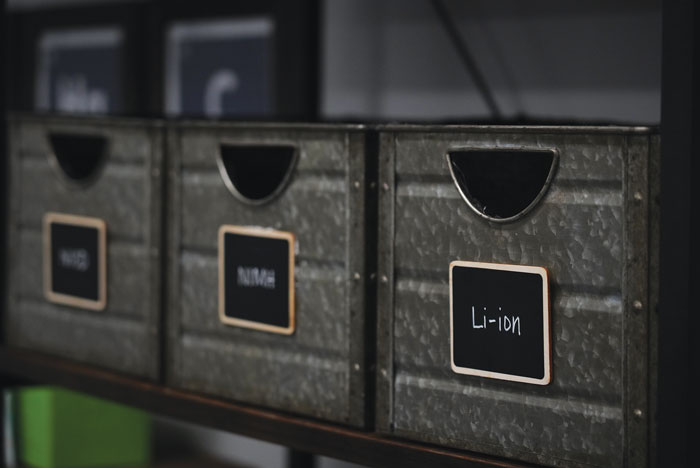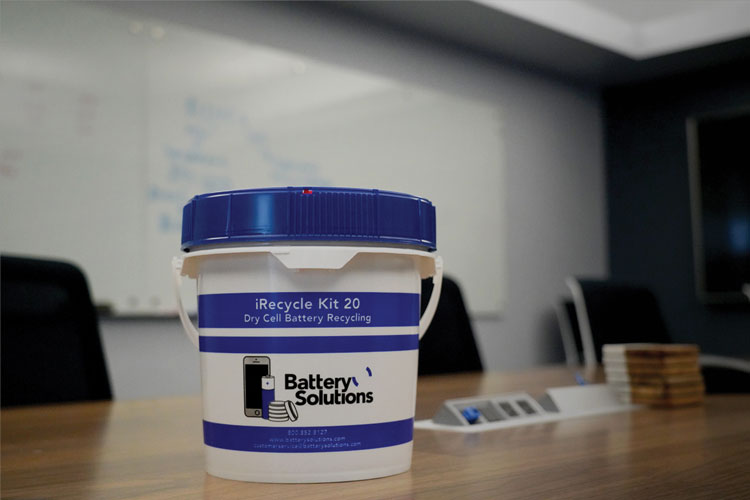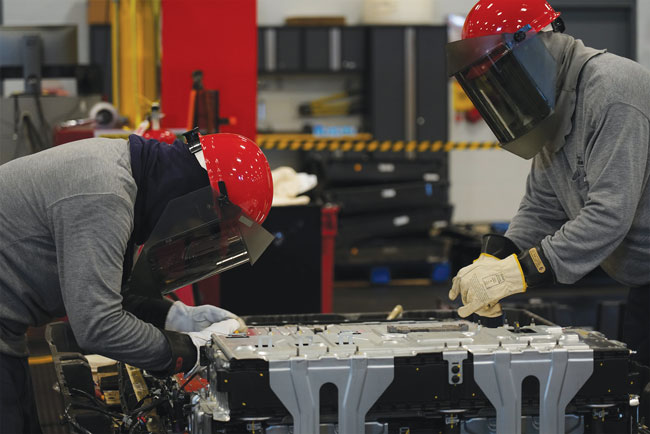As battery technologies continue to evolve, it is critical to understand disposal and safe handling practices.
By Danielle Spalding
Commercial lithium-ion batteries entered the market around 1991 and changed the landscape in battery technology. Their quick growth in popularity can be expressed by their characteristics of being lightweight, having a high energy density, low self-discharge rates and the ability to hold a charge. Up until this point, lead was a dominate force in the battery game.
After the new millennia, access to cell phones and portable electronic devices grew. Today, it is estimated that more than 294 million people in the U.S. have a smartphone and it is hard to walk down a street and not see someone using wireless headphones. All of these devices are powered by lithium-ion batteries. There are also impacts to stationary power, transportation, retail and healthcare sectors to name a few.

As lithium-ion batteries became more common place in businesses and homes, the profile for properly handling of these batteries rose. Fires from batteries in devices have been highly publicized in the last several years—from incidents on airplanes to explosion on trains. While the lithium-ion battery has been in use for more than 30 years, it has only been in recent years that it has become common place. As this item integrated itself into commonly used items, education became apparent.
Cause of Fires
One main educational point is to not include lithium-ion batteries in your curbside recycling bin. At the beginning there was not much communication on what to do with these batteries at their end-of-life, because there was not a large volume in the marketplace. Once market share grew, the effects of the batteries at material recovery facilities became more visible. Once material is picked up curbside, it is placed in a collection truck. Material is then crushed down and if a puncture occurs or if there is metal-to-metal contact in the wrong way, there is potential for a thermal runaway event. Residents may also put a damaged or defected battery in a recycling bin and that could be another cause leading to events such as truck fires.
Once the material reaches a recycling facility, it is sifted through for sorting into common materials and if a battery is again damaged in some way before or after it gets there, this may lead to fires at these locations. Lithium-ion batteries are considered the most common reason for fires at recycling plants today. Centers have had to close for weeks at a time in order clean-up, check equipment and ensure everything is in place before they reopen.
Battery recycling is a specialty in sustainability efforts, just as plastics and paper have been. Battery chemistries have different processing types, and lithium-ion is no exception. Previously, batteries would be collected and sent overseas for recycling. Now, recycling processes have been established in North America and more precisely in the U.S. From national grants, down to the state level, there is a push to support solutions for lithium-ion batteries. An example of this support is demonstrated by The Lithium-Ion Battery Recycling Prize, a competition that is part of the American Made Challenges by the Department of Energy. This competition was created to support entrepreneurs in the U.S. and put a focus on the goal of a high capture rate of spent lithium-based batteries. Michigan’s NextCycle is another respected approach that includes a grant focused on the electric vehicle battery recycling market. The competitions and grants for spent lithium batteries at all of levels is a tribute to the commitment that so many have to provide environmental and economically friendly solutions.

Safety and Collection Considerations
Safety is the other key area of consideration in the recycling process, and it starts at the collection point. From pickup, batteries must be packaged properly. From trainings by leaders like battery collection companies and recycling associations such as ISRI, there are a range of regulations to understand to ensure batteries are taped or wrapped properly. The Department of Transportation has lithium specific requirements, and there are potentially more down the road. For businesses, they may work through their waste management group or directly with a battery recycler depending on their needs.
That leaves the question, if you should not put your lithium-ion batteries into curbside bin, then what do you do with them? This need has created many solutions in the marketplace—from bringing your items to a hazardous waste collection day hosted by your local community, to dropping them off at a retail or bringing battery recycling directly to your door with recycling kits that are now widely available for anyone to purchase if they are looking to expand their at home sustainability commitment.
Once those items are collected and received, they need to be stored and this is where safety is another key component. Not all facilities are set up to store lithium batteries. From specialized racking to thermal monitoring, safety should be the first priority when it comes to handling the risks of lithium-ion batteries. It is important to remember that lithium-ion batteries come in all shapes, sizes and formats. We need to have solutions for all of them.1

Processing
Another growing sector within recycling is lithium-ion processing—a niche even within battery recycling. This is an important area that is growing rapidly. For example, large format lithium-ion batteries, such as electric vehicles, create an increased need for disassembly in facilities to ensure processing facilities receive their specific requirements. This type of work is expanding the jobs within the sustainability field.
There is no one single process or best practice for lithium-ion yet. From hydrometallurgical to pyrometallurgical, and even direct use, the range of processing approaches continue to expand. This is another area creating new jobs, investment opportunities and helping to expand the depth of battery recycling in the U.S. As processing matures for this battery chemistry, the hope is recycling rates will significantly increase in this area.
A Changing Marketplace
It is amazing how one battery type has changed a marketplace, from disposal to battery recycling education, the safe handling of these materials, and the creation of new jobs in recycling technology and collection. This is an important and critical battery technology that will continue to evolve. It is key to ensure that you partner with a team that finds the right solution for your needs.| WA
Danielle Spalding is Director of Marketing and Communications for Battery Solutions. She can be reached at (248) 446-5632 or e-mail d[email protected].
As one of the many companies that work in this sector, Battery Solutions places a strong value on education and training for customers and community and has seen first-hand the market shift of battery chemistries. As the market has changed to lithium-ion, Battery Solutions has had the privilege to adapt by providing solutions for customers. For more information, visit www.batterysolutions.com.
Note
1. Thomas Bjanermark, CEO at Battery Solutions
